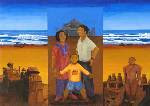(By Nalini S Malaviya)
These monochromatic paintings on paper are outstanding examples of tribal art done by Meena women from Rajasthan. Intricate designs of animals, birds and other motifs have been painted in exquisite detail. White pigment on brown paper has a stark yet delicate effect that resembles lacework, at times. A tree surrounded with parrots, tiger, peacocks and lotus flowers have been represented through linear drawings. Geometric patterns have also been used to fill up space and add decorative value. The result is quite stunning, especially because some of the works have been done on very large panels. What is also interesting is that most of these paintings are a result of group efforts yet it is impossible to detect any blemishes or oversights.

The Meena tribe is an ancient tribal group living in the eastern part of Rajasthan. The art form called ‘Mandana’ is practiced exclusively by women. For them it is an expression of joy on festive occasions. It is done on the mud walls of houses and traditionally, colored glass, beads, mirrors and stones are also used to decorate these paintings. The conventional art form is created using white chalk and brushes made of khajur or bamboo sticks. The end of the stick is crushed to form fine bristles. The mandanas are painted on walls and floors. Often, geometric patterns are painted on walls, while representational forms of animals, birds, plants and flowers are painted on the walls.
The exhibition titled ‘Joy of Creativity’ is on view till April 10 at Karnataka Chitrakala Parishath, Kumara Krupa Road and at Time and Space Art Gallery, # 55, Lavelle Road, Bangalore.
(Published in FT, Bangalore)
These monochromatic paintings on paper are outstanding examples of tribal art done by Meena women from Rajasthan. Intricate designs of animals, birds and other motifs have been painted in exquisite detail. White pigment on brown paper has a stark yet delicate effect that resembles lacework, at times. A tree surrounded with parrots, tiger, peacocks and lotus flowers have been represented through linear drawings. Geometric patterns have also been used to fill up space and add decorative value. The result is quite stunning, especially because some of the works have been done on very large panels. What is also interesting is that most of these paintings are a result of group efforts yet it is impossible to detect any blemishes or oversights.

The Meena tribe is an ancient tribal group living in the eastern part of Rajasthan. The art form called ‘Mandana’ is practiced exclusively by women. For them it is an expression of joy on festive occasions. It is done on the mud walls of houses and traditionally, colored glass, beads, mirrors and stones are also used to decorate these paintings. The conventional art form is created using white chalk and brushes made of khajur or bamboo sticks. The end of the stick is crushed to form fine bristles. The mandanas are painted on walls and floors. Often, geometric patterns are painted on walls, while representational forms of animals, birds, plants and flowers are painted on the walls.
The exhibition titled ‘Joy of Creativity’ is on view till April 10 at Karnataka Chitrakala Parishath, Kumara Krupa Road and at Time and Space Art Gallery, # 55, Lavelle Road, Bangalore.
(Published in FT, Bangalore)

 Surjit has returned to painting after a gap of several years and has taken off from where he left. He has experimented with reverse painting and hopes to utilize printmaking techniques with painting mediums in his next show. He has done BFA (painting) and MFA (print-making) from M. S. University, Baroda.
Surjit has returned to painting after a gap of several years and has taken off from where he left. He has experimented with reverse painting and hopes to utilize printmaking techniques with painting mediums in his next show. He has done BFA (painting) and MFA (print-making) from M. S. University, Baroda.